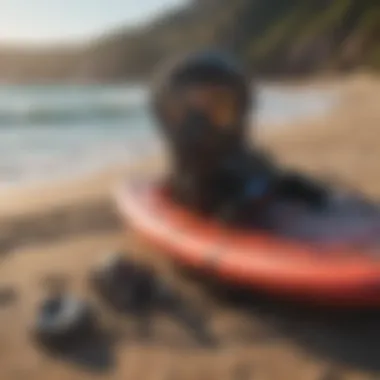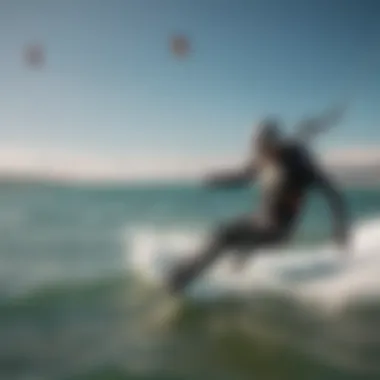Kite Board Training: A Comprehensive Guide


Intro
Kite boarding is not just a sport; it is a passionate pursuit that captivates enthusiasts worldwide. The thrill of gliding across the water while harnessing the wind's power can be both exhilarating and demanding. To excel in this sport, adequate training is of paramount importance. This comprehensive guide aims to profile essential aspects of kite board training, including the right equipment, techniques, safety measures, and training best practices.
Navigating the vast world of kite boarding often begins with understanding the foundational equipment. Each piece of gear plays a crucial role in ensuring not only performance but also safety. The journey from novice to skilled kiteboarder requires not only technical skills but also a strong awareness of environmental factors, conditioning, and navigation techniques. This guide provides the necessary information to navigate these complexities efficiently.
By exploring various training methodologies, students and instructors alike can enhance their expertise. This framework adapts to individuals at all skill levels, emphasizing that growth in kite boarding is a continuous process. The following sections will delve deeper into each element, laying out a structured approach to becoming a proficient kiteboarder.
Preface to Kite Board Training
Kite board training serves as the foundation for anyone looking to excel in kiteboarding. Understanding the various aspects of this sport can greatly influence one’s experience and safety on the water. Training is not merely an option; it is essential for developing the skills needed to navigate the complexities of kiteboarding.
Understanding Kiteboarding
Kiteboarding combines elements of surfing, windsurfing, and paragliding, requiring both skill and strategy. The rider uses a board and a power kite to glide across water surfaces. This sport relies heavily on understanding wind conditions and kite control. Newcomers often face initial challenges, including mastering the kite and balancing on the board. Therefore, knowledge of the sport's fundamentals cannot be overstated. It is crucial since it lays the groundwork for future success.
Moreover, an in-depth understanding of kite dynamics helps in choosing the right equipment. Each kite and board has unique characteristics designed for various conditions and styles. As such, familiarity with kiteboarding aids in making informed decisions that can improve performance and enjoyment.
The Role of Training in Kiteboarding Success
The role of training in kiteboarding success is multifaceted. Training is not just about learning to ride; it encompasses safety practices, technical skills, and physical conditioning. Practicing regularly enhances muscle memory, making the necessary movements more instinctive over time.
Additionally, structured training can lead to quicker progression. Whether you are a beginner or an experienced rider looking to refine your skills, systematic training provides a pathway to reach your goals. Furthermore, a well-rounded approach includes understanding safety measures, making it possible to minimize risks effectively.
"Training is the bridge between knowledge and skill, allowing kiteboarders to harness the elements safely and effectively."
Training sessions should ideally include a blend of theory and practice. Participants should spend time learning about wind conditions, safety protocols, and gear maintenance along with on-water practice. Engaging in diverse training methods can lead to a comprehensive skill set, further enhancing the kiteboarding experience.
In summary, kite board training significantly impacts one’s performance. An understanding of the sport's complexity, paired with adequate training, empowers athletes to enjoy kiteboarding to the fullest while mitigating potential risks.
Essential Equipment for Kite Board Training
Having the right equipment is crucial for kiteboarding success. This section discusses the various pieces of gear that can significantly affect performance and safety. The correct gear not only enhances the kiteboarder's experience but also minimizes risks associated with the sport.
Choosing the Right Kite
Selecting a kite involves understanding specific characteristics that suit individual needs. Kites come in various shapes, sizes, and types. Each type interacts differently with wind conditions.
- Type of Kite: There are primarily two types: the delta and the bow kite. Delta kites offer stability and ease of handling, which is beneficial for beginners. Bow kites are known for their versatility and are preferred by advanced riders for performance.
- Size Matters: The kite size is another vital factor. Larger kites catch more wind, offering more power. However, they can be harder to control. Smaller kites provide less power but are easier to manage, making them suitable for lighter winds.
- Skill Level Considerations: A beginner should focus on a user-friendly model that has forgiving characteristics. More experienced kiteboarders can experiment with performance-focused kites that allow for advanced maneuvers.
Selecting Your Board
Just like kites, boards also come in different types and styles. A well-chosen board allows for better performance and efficiency on the water.
- Types of Boards: There are twin-tips and directional boards. Twin-tips allow for riding in both directions, offering flexibility. Directional boards are more specialized and often preferred for surf-style riding.
- Material and Construction: The materials used in construction can dictate performance and durability. Boards made from lightweight materials are easier to maneuver but might sacrifice strength, while heavier boards provide stability but require more effort to control.
- Board Size: The size of the board should correlate with the rider's weight and skill level. A larger board provides better floatation, making it easier for beginners. Meanwhile, an experienced rider might choose a smaller board for increased responsiveness.
Harness and Lines: What to Consider
Harnesses and lines are often overlooked but play a critical role in comfort and control during kiteboarding.
- Types of Harnesses: There are two main types: seat harnesses and waist harnesses. Seat harnesses offer more support for beginners, especially when adjusting to the sport. Waist harnesses allow for greater mobility and are often favored by skilled riders for their versatility.
- Line Quality: The lines that connect the kite to the harness should be strong and durable. Choosing high-quality materials ensures that the lines can withstand the forces exerted while kiteboarding.
- Comfort: Wearing a harness that fits well is essential. An ill-fitting harness can cause discomfort and distract from focusing on riding. Riders should try on different models to find the best fit.
A well-thought-out gear selection leads to a better learning experience. The right equipment enhances both safety and enjoyment on the water.
In summary, the right equipment lays the foundation for successful kiteboard training. Whether it's kites, boards, lines, or harnesses, each element plays a significant role in ensuring a safe and enjoyable experience.
Technical Skills for Beginners


The foundation of kiteboarding rests on a set of essential technical skills. For newcomers, these skills are crucial for safety and enjoyment in the sport. Without them, the risk of accidents increases. Thus, understanding these basic skills is paramount for anyone looking to progress in kiteboarding. Each skill serves as a building block for more advanced techniques, creating a seamless transition into higher levels of expertise.
Understanding Wind Dynamics
Wind dynamics play a central role in kiteboarding. Kiteboarders must grasp how wind interacts with their kite and the water. Knowledge about wind direction, speed, and strength is vital. The right wind conditions dictate the type of kite to use and the overall feasibility of a session.
Elements of Wind Dynamics:
- Wind Direction: Knowing where the wind comes from is critical for determining launch and landing zones.
- Wind Speed: Winds can vary from light to strong. Each kite has a recommended wind range. Managing different wind speeds affects control and performance.
- Wind Shear: This occurs when wind speed or direction changes at different altitudes. It can impact stability while riding.
Understanding these factors ensures that kiteboarders can make informed decisions in terms of gear choice and overall safety.
Basic Kite Control Techniques
Mastering kite control is fundamental in kiteboarding. It establishes confidence and enhances overall performance on the water. Techniques for basic control include launching, landing, and maneuvering the kite effectively.
Key Techniques for Control:
- Launching the Kite: This process involves understanding how to set up and lift the kite efficiently, ensuring it catches the wind without any complications.
- Flying the Kite: Control comes from proper input on the bar. Movements should be smooth and intentional. Learning how to steer and maintain the kite's position minimizes the chances of stalling.
- Landing the Kite: Safely bringing the kite back down requires attention to both wind conditions and kite positioning. Using techniques to slow down the descent can help avoid damage.
Practicing these control techniques will boost self-confidence and improve riding ability.
Board Handling: The First Steps
Once kite control is mastered, board handling becomes the next focus. Feeling at ease with the board boosts the ability to ride efficiently and confidently. New riders should begin with dry land practice before moving onto the water.
Initial Steps for Board Handling:
- Putting on the Board: This seems simple but getting comfortable while strapped into a board can take practice. Strapping in securely is essential to avoid losing board control.
- Practicing Water Starts: Learning to get from a seated position to standing while in the water is crucial. Researching the technique can aid in this process as it combines kite control and stability on the board.
- Balancing on the Board: Once the board is underway, balance is paramount. New riders should spend time simply practicing maintaining balance while managing kite control.
By focusing on these initial steps with the board, novices can set themselves up for future success in more demanding techniques and challenges in the kiteboarding realm.
Advanced Techniques and Progression
As kiteboarding skills evolve, the pursuit of advanced techniques becomes vital for enhancement and creativity. This section explores essential areas that elevate a kiteboarder's proficiency and enjoyment. Mastering advanced techniques not only furthers individual capability but also fosters confidence and safety during high-stakes maneuvers.
Transitioning Between Stances
Learning to transition between stances is key for kiteboarders looking to expand their skill set beyond basic riding. Riders often switch between regular and goofy stances, making it easier to navigate various conditions and perform tricks effectively. The following elements are crucial to consider:
- Smooth Transition: Riders should practice shifting their weight from one foot to another while maintaining balance. A fluid transition enhances control.
- Timing with Wind: Understanding wind shifts helps riders anticipate the best moment to switch their stance. Proper timing prevents loss of power and control.
- Practice in Safe Conditions: Ideal weather conditions, such as moderate winds, provide safer environments to practice stance transitions. Gradually increasing difficulty can help build proficiency.
"Transitioning smoothly empowers riders to explore complex tricks, improving overall performance."
Jumping and Tricks
Jumping is a hallmark of kiteboarding, offering excitement and a sense of freedom. This skill involves various techniques, each requiring practice and precision. Key considerations include:
- Pop Technique: Learning how to pop off the water is fundamental. A rider must create upward force through edging and timing to gain altitude.
- Proper Kite Position: The kite should be pulled back to provide lift during jumps. Incorrect positioning can lead to underwhelming jumps or descents.
- Trick Progression: Start with simple jumps, gradually escalating to complex tricks. Basic aerial maneuvers serve as a foundation for advanced tricks such as spins or rotations.
Dynamic Riding Skills
Dynamic riding skills incorporate advanced techniques with real-time adaptability on the water. This involves:
- Riding in Different Conditions: Navigating choppy waters or strong winds requires agility and awareness. Mastery in dynamic riding enhances the kiteboarder's ability to handle variable conditions efficiently.
- Reading the Environment: Great kiteboarders can assess their surroundings and modify their technique accordingly. This includes observing wave patterns and wind currents, tailoring the kite and board movements to optimize ride.
- Control Over Height: Riders need to learn how to adjust their height in the air for landing and maneuvering effectively. Understanding how to manage line tension while airborne directly impacts trick performance.
In summary, advancing one’s kiteboarding skills takes time and effort. Engaging in activities like transitioning between stances, mastering jumps, and honing dynamic riding abilities will elevate any rider’s experience and safety. By focusing on technique, kiteboarders can ensure not only growth but also a lifelong enjoyment of the sport.
Safety and Risk Management


Safety and risk management are crucial components of kiteboarding training. This not only enhances the training experience but also significantly reduces the risk of injury. Kiteboarding can be exhilarating; however, the sport also carries inherent dangers. By understanding these risks and implementing proper safety protocols, both novice and experienced riders can enjoy kiteboarding with greater peace of mind.
Understanding Kiteboarding Risks
Kiteboarding involves various risks, including drownings, collisions, and equipment failure. Understanding these risks is the first step toward preventing accidents. Common issues include:
- Wind Conditions: Sudden changes in wind can lead to dangerous situations.
- Water Hazards: Obstacles such as rocks and shallow water may cause injuries.
- Equipment Malfunction: Failure of the kite or lines can lead to accidents.
Preparedness is crucial. Always check the wind conditions before heading out. Avoid areas with known hazards and regularly inspect your gear for signs of wear or damage.
Essential Safety Gear
Safety gear is an essential part of kiteboarding. The right equipment can make a significant difference in protecting yourself from injury. Consider having the following:
- Impact Vest: Provides protection from impacts and also aids in buoyancy.
- Helmet: Essential for head protection, particularly in crowded or challenging environments.
- Foot Straps and Pads: Ensure a secure fit and prevent slipping off the board.
It's important to choose high-quality gear from reputable brands. Make sure that all safety equipment fits well, is comfortable to wear, and is suitable for the conditions you expect.
Launching and Landing Protocols
Correct launching and landing techniques are vital for maintaining safety in kiteboarding. These protocols can be the difference between a successful session and a dangerous situation. Here are some essential tips:
- Launching: Always launch with a trusted partner who can assist you. The kite must be angled properly against the wind. Ensure the area is clear of obstructions and others.
- Landing: Communicate your intention to land clearly with those around you. Control the kite, slowly bringing it down as you approach the ground. A soft landing can prevent damage to the equipment and injuries.
"Proper safety protocols not only protect the rider but also create a safer environment for everyone on the water."
Practicing these techniques with supervision or instruction will enhance your safety and skill.
Implementing a rigorous approach to safety can significantly elevate your kiteboarding experiences. Understanding the risks, investing in the right equipment, and mastering launching and landing techniques are indispensable elements of effective kiteboard training.
Physical Conditioning for Kiteboarders
Physical conditioning is critical for kiteboarders who want to improve their performance and reduce the risk of injury. Kiteboarding requires a unique blend of strength, endurance, and flexibility to maneuver effectively on the water. A well-designed training program can enhance power, control and overall riding experience. Additionally, kiteboarding can be physically demanding, often requiring sustained effort in challenging conditions. Therefore, focusing on physical conditioning allows kiteboarders to maintain their stamina and skill levels across varied environments.
Strength Training Specific to Kiteboarding
Strength training is essential for kiteboarders, as it directly impacts their ability to control the kite and board. Key muscle groups used in kiteboarding include the core, legs, and upper body.
- Core Stability: A strong core helps maintain balance during maneuvers. Exercises such as planks, Russian twists, and leg raises can build core strength.
- Leg Strength: Strong legs are necessary for powerful take-offs and transitions. Activities like squats, lunges, and deadlifts target the quadriceps, hamstrings, and calves.
- Upper Body Strength: Upper body strength contributes to controlling the kite. Pull-ups, push-ups, and resistance band exercises can improve strength in the shoulders and back.
A combination of these exercises ensures that kiteboarders develop the necessary muscles to perform optimally. Gradually increasing weights and intensity will yield sustainable results over time.
Endurance and Flexibility Exercises
Endurance and flexibility are crucial not only for performance but also for recovery and injury prevention.
- Endurance Training: Cardio workouts like running, cycling, and swimming enhance cardiovascular fitness. A strong heart and lungs allow kiteboarders to ride longer and recover quicker. Aim for a minimum of three cardio sessions each week, gradually increasing duration and intensity.
- Flexibility Training: Flexibility helps in improving range of motion, which is vital when executing tricks and various maneuvers. Stretching routines that focus on the hamstrings, quads, shoulders, and back can be particularly beneficial.
Incorporating yoga or Pilates into the training regimen is another effective way to enhance both flexibility and mindfulness. By committing to both endurance and flexibility routines, kiteboarders can not only boost their performance but also enjoy a longer and healthier kiteboarding journey.
Staying physically fit will not only help with your kiteboarding skills but also extend your ability to enjoy the sport throughout your life.
Physical conditioning can be integrated into a kiteboarder's regular practice schedule. Striking a balance between riding and training results in a comprehensive approach to improving skills, maintaining health, and ensuring safety on the water.
Environmental Considerations
Understanding the environment is crucial for kiteboarders. The right conditions can significantly affect performance and ensure safety. Environmental considerations cover two main aspects: water conditions and weather patterns. Each factor plays a vital role in a kiteboarder's experience and success.


Understanding Water Conditions
Water conditions vary widely depending on location and time. Aspects such as wave height, current strength, and water temperature impact both enjoyment and skill development.
- Wave Height: For beginners, small waves are manageable, reducing the chance of falls. More experienced riders may prefer bigger waves for more dynamic riding.
- Current Strength: Strong currents can be challenging. They can lead to difficult launching or landing situations. Knowledge of local currents is essential to avoid hazardous areas or unexpected situations.
- Water Temperature: Cold water can lead to hypothermia. Wearing appropriate wetsuits or drysuits is necessary to maintain safety. Warm water, on the other hand, enhances comfort, enabling longer sessions on the water.
Understanding these water dynamics allows kiteboarders to prepare properly and improve their skills onsite.
Weather Patterns That Affect Kiteboarding
Weather is a powerful influence on kiteboarding. Conditions such as wind speed, consistency, and direction are paramount.
Wind Speed: Each kitesurf setup has optimal wind ranges. Too much wind can overpower novices, while too little may frustrate experienced riders. Thus, understanding local wind conditions and forecasts is beneficial.
Wind Consistency: Gusty winds can create unstable flying. Consistent winds lead to a more enjoyable ride and easier skills learning.
Wind Direction: Knowing how the wind interacts with local geographical elements is essential. Side-onshore winds typically provide a safer experience than offshore winds.
"Kiteboarding success hinges on one’s ability to read and adapt to environmental variables."
In summary, kiteboarders must pay attention to environmental considerations. Knowledge of water conditions and weather patterns is vital for safety, skill improvement, and overall enjoyment. Professional training programs often stress this importance to enhance rider capabilities while fostering an awareness of the surroundings.
Community and Learning Resources
In kiteboarding, community and learning resources are crucial for both novice and seasoned riders. These resources help individuals connect with others who share their passion, while also providing valuable information that can significantly enhance their skills. Engaging in a vibrant community fosters support, motivation, and shared knowledge, making the learning process more enjoyable and effective.
Access to kiteboarding schools and instructors not only aids in learning but also ensures that safety protocols are properly followed. Professional guidance can accelerate the learning curve, allowing novice kiters to grasp essential techniques more quickly. Additionally, kiteboarding schools act as community hubs, where both beginners and experienced kiteboarders can share experiences and tips, facilitating growth and camaraderie.
The online landscape provides numerous forums and social media platforms for kiteboarders to engage with each other. These spaces become informational treasures where practitioners discuss various aspects of kiteboarding, share videos of their sessions, and offer advice on the latest equipment.
"Building connections within the kiteboarding community can lead to lifelong friendships and a wealth of knowledge that transcends traditional training methods."
Finding Kiteboarding Schools and Instructors
When searching for kiteboarding schools and instructors, it is essential to prioritize quality and reputation. Here are several steps to consider:
- Research: Look for schools with strong online presences and positive reviews. Websites like Wikipedia and Britannica can provide general insights.
- Instructor Qualifications: Ensure instructors are certified. Look for affiliations with recognized organizations, like the International Kiteboarding Organization (IKO).
- Local Conditions: Choose schools that offer training in safe and suitable environments. Understand the local wind conditions and water features to ensure optimal learning.
- Trial Lessons: Many schools offer introductory lessons. These provide opportunities to assess instructor style and the school's environment before committing to a full course.
Online Forums and Social Media Engagement
Online forums and social media platforms serve as invaluable resources for kiteboarders seeking advice, sharing experiences, or simply connecting with like-minded enthusiasts. Platforms like reddit.com host subreddits dedicated to kiteboarding that facilitate discussions on various topics. Here are some benefits of engaging in these online spaces:
- Networking: Join groups on Facebook or forums to connect with experienced riders and get local insights.
- Knowledge Sharing: Participants can ask questions and receive diverse answers based on real-world experiences.
- Equipment Recommendations: Communities often share reviews and personal tips on gear, which can guide purchase decisions.
- Event Announcements: Staying updated on local competitions, meet-ups, and social gatherings becomes easier through these channels.
In summary, the combination of physical training through certified instructors and virtual interaction via forums and social media forms a well-rounded foundation for kiteboarders of all skill levels. Embracing these resources allows individuals to enhance their skills and enjoy the full benefits of the kiteboarding experience.
Ending and Future Outlook
The concluding section of this guide holds significant importance. It encapsulates the essence of kiteboarding training and underscores the need for continued evolution in skills and understanding. Kiteboarding is more than just a sport; it is a lifestyle that demands a commitment to learning and adapting. The landscape of kiteboarding is ever-changing, influenced by technological advancements, environmental shifts, and evolving techniques. Thus, continuous learning is paramount for any kiteboarder wishing to stay ahead in the game.
The benefits of ongoing education within this sport are substantial. It ensures that practitioners are less prone to accidents due to a better understanding of gear and conditions. Also, it enhances enjoyment, allowing kiteboarders to explore various styles and challenges. Engaging with communities, attending workshops, or participating in competitions fosters an environment for mutual growth and knowledge-sharing.
Continuous Learning in Kiteboarding
The landscape of kiteboarding is filled with opportunities for continuous learning. The techniques and equipment used are becoming more sophisticated, and remaining informed about these advancements is crucial. Kiteboarders can enhance their skills through various means:
- Workshops and Certifications: Many schools offer structured programs for all skill levels. Enrolling in these workshops can provide formal training on advanced techniques.
- Online Resources: Utilizing platforms like Reddit and Facebook groups can connect kiteboarders to a wealth of shared experiences and advice.
- Videos and Guides: Watching tutorial videos from professional kiteboarders can expose learners to new maneuvers and skills, offering a visual understanding that is often more impactful than reading.
It is also essential to analyze one’s progress critically. Keeping a journal of experiences can help identify strengths and areas that require improvement.
Embracing the Kiteboarding Lifestyle
Kiteboarding extends beyond the act itself; it embodies a way of living. Embracing this lifestyle brings numerous advantages:
- Connection with Nature: Kiteboarding fosters a deep appreciation for water and wind. Engaging with these elements can lead to a better understanding of environmental stewardship.
- Building Community: The kiteboarding community is diverse and supportive. Shared experiences can lead to friendships that extend beyond the water.
- Personal Growth: Overcoming challenges in kiteboarding builds confidence and resilience. This personal development translates into other life aspects.







